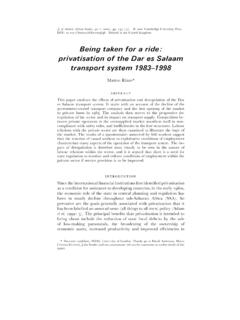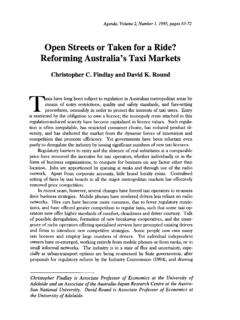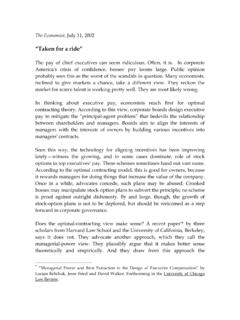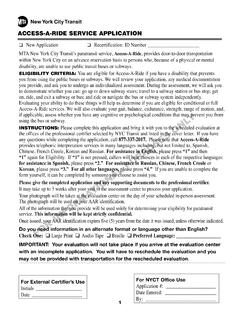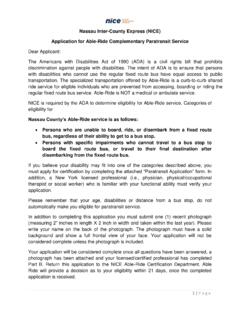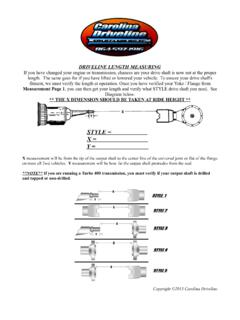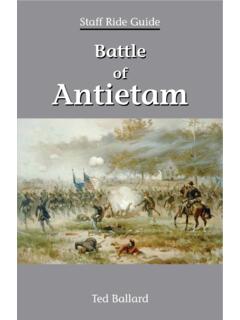Transcription of AERC RIDE MANAGER’S HANDBOOK
1 TABLE OF CONTENTSI ntroductionWhat is AERC?What is an Endurance ride ?Endurance ride Variations One-Day Rides Elevator Rides Two-Day Rides Multi-Day Rides AERC Limited Distance RidesGeneral Information AERC Sanctioning RequirementsPhysical Considerations Choosing a Campsite Establishing the Trail Permission to Use Land Trail Layout Creating or Clearing a Trail Measuring the Trail Marking the Trail Marking Supplies Day Markings Night Markings Turns and Trail Splits When to MarkVet Check SitesStart and FinishOther Considerations Budget Publicity ride Flyer Food WaterThe Day Before Rider Registration Rider Packets Rider (Vet) Card Trail Maps Rider List Meal Tickets Pre- ride Vet Check Identifying Competitors Pre- ride BriefingRide Personnel and Duties ride manager ride Secretary ride Veterinarians Veterinarian Recorder (Secretary)
2 Pulse and Respiration Personnel Timers Spotters Drag Riders Farrier ride StewardVeterinary Control General Pre- ride Check Vet Check Types Gate into Timed Hold Gate or Stop and Go Check Ten/Ten Check Fixed Hold Post-Finish Check Best Condition JudgingAfter the ride Finish Awards Awards Presentation CeremonyRide Follow-up Tabulating ride Results Sending Results to AERC Other Post- ride ResponsibilitiesAPPENDIX ARide Management ChecklistAPPENDIX BAERC Forms ride Sanctioning Application ride Change Request AERC Recommended Rider Card Best Condition Judging Form ride Results FormAPPENDIX CThe Computer as a ride Management Tool APPENDIX D ride Management Forms Sample ride Entry Form Sample Alternative Rider Card Sample Timer Sheet Sample Finish Line Form Setup for Recording Entries Setup for Registering Riders Report for AERC ride ResultsAPPENDIX EGuidelines for Endurance Rides on National Forest, BLM, National or State Park LandsAERC ride manager S HANDBOOKR evised January 2008 INTRODUCTIONE ndurance rides are sanctioned by the American Endurance ride Conference.
3 To qualify for sanctioning, an endurance ride must meet certain standards, described in the AERC rule book and this HANDBOOK . These standards include being at least 50 miles in length per day, up to 155 miles in three days, run under specific veterinary controls, and being open to all equines. Multi-day rides or Pioneer rides, often using historic trails, are 155 miles in three days, or greater, and require special sanctioning approval by the Board of Directors (BOD). If these rides have taken place successfully without negative incident for two consecutive years, sanctioning can thereafter be approved directly by the regional sanctioning organizing a ride , you must provide: equal opportunities, equal treatment and equal judgment to all competitors.
4 This in-cludes not only the veterinary supervision but also the manage-ment of the entire an endurance ride can be both gratifying and frus-trating! But it s a great way for a rider to give back to the sport and for a non-riding horse lover to promote this wholesome sport. This HANDBOOK will help both the first-time and the experienced ride Managers (RM) to produce a successful ride . Please read it carefully and be certain to read the AERC Rules, as it is essential that they govern your ride at all IS THE AERC?The American Endurance ride Conference (AERC) was founded in 1972 as a sanctioning body for distance events and record-keeping organization for riders and their horses compet-ing in distance events. AERC currently has both Senior and Junior divisions.
5 Junior riders are under 16 years of age as of December 1st of the current riding year and usually must ride with an adult sponsor (age 21 or over). Exceptions are explained in the AERC rules. Senior riders are divided into four weight divisions: Featherweight (up to 160 pounds), Lightweight (161-185 pounds), Middleweight (186-210 pounds) and Heavyweight (211 pounds and over). These weights include all tack. AERC members declare their weight division at the beginning of the ride year and may submit a change in division up to June 1 of the ride season. No changes are accepted after June member of AERC has a rider ID number by which he is identified in all AERC records. A non-member must pay a $15 non-member fee (it could be called a one-day membership fee) when he/she enters your ride .
6 As a ride manager , you must be certain that each rider has a valid number, unless he/she declares to be a non-member. If a rider gives you a non-valid number, you will be responsible for either collecting the non-member fee from the rider or pay it yourself out of ride funds. The AERC office will be happy to verify any membership number given you by an entering rider if you have any reason to suspect the number is invalid (as in the case of a lapsed membership).After a rider has completed 250 miles of endurance rides, he/she will receive a rider patch and a chevron. Chevrons are awarded in 250-mile increments until 1,000 miles are attained. After 1,000 miles, the chevrons are awarded in 1,000-mile increments. Members are asked to register their equine with AERC before the equine begins competition.
7 Each equine will receive an iden-tifying number that must be used when entering a ride in order to ensure the proper mount receives the mileage and bonus credits. Horse names are often difficult to read and riders may use stable names; using the equine ID number lessens the chance of error. Equines receive medallions upon completion of 1,000 miles of sanctioned rides and for each additional 1,000 AERC has a variety of year-end awards, both national and regional. Further information is available from the AERC office, Box 6027, Auburn, CA 95604; phone: 530-823-2260 or toll-free 866-271-2372; fax: 530-823-7805; e-mail: website: IS AN ENDURANCE ride ?An endurance ride can best be described as a cross-country contest of 50 or more miles. It is an equestrian athletic event with the same equine and rider covering a measured course within a specified maximum time.
8 It is controlled by equine veterinarians who monitor the equines before, during and after the competi-tion. There will be one or more veterinary checkpoints during a 50-mile ride , typically one at a midway point for a one-day leg of a multi-day ride and two to three or more for a one-day stand-alone event. Equines must be at least 60 months of age to compete in an endurance recovery is an important indicator of physical condition in both athletic humans and equines. The ride veterinarians will set the pulse criteria and announce it before the start of the ride . The equines are also monitored for other physical responses including lameness. Those not meeting the parameters are disqualified. The first equine across the finish line and judged in satisfactory physical condition ( fit to continue ) is the overall winner.
9 To protect the equines and to ensure fairness of competition, equines must not be influenced by any drug, medication or veterinary , the word horse is to be understood as any breed of equine horse, mule, pony, donkey, or even a zebra, should anyone choose to ride one, and is interchangeable with the word equine. Some breed associations automatically endorse, for their own performance programs, a ride sanctioned by the AERC. These may include the International Arabian Horse Association, the Appaloosa Horse Club, the American Morgan Horse Association, and the Pony of the Americas. Because horse and rider records and awards are based on the results of AERC sanctioned rides, it is absolutely necessary to put on endurance rides conforming to the AERC rules.
10 The suggestions and standards set forth in this booklet will help you do ride VariationsOne-Day Rides. Endurance rides are a minimum of 50 miles (12 hour maximum time for completion, including vet checks), and more 50 milers are sanctioned than any other distance. However, there is a large variety of rides and combination of rides available. Probably the most popular longer distance is the one-day 100 mile (24 hour maximum time for completion, including vet checks). The AERC rules allow any distance from 50 to 150 miles under the same ride name. You can, for example, have a 50, a 70, and a 100-mile ride all in one day or up to 155 miles in three days. You could even have up to 150 miles in two time allowed is incremental based on adding one hour and 15 minutes for every five additional miles over 50.
